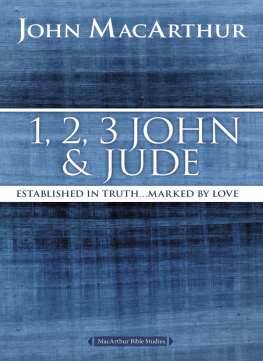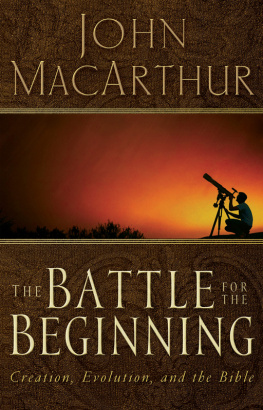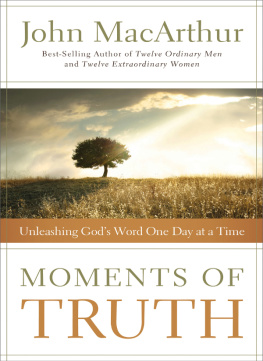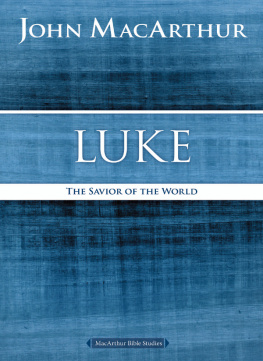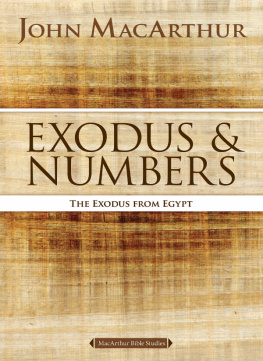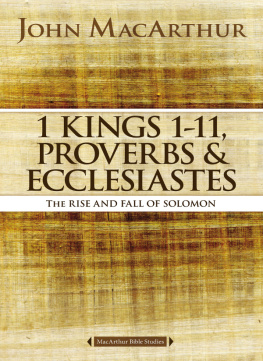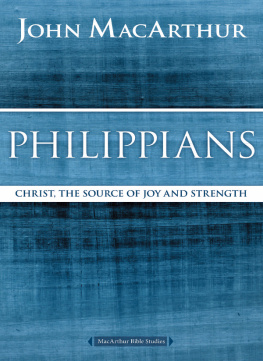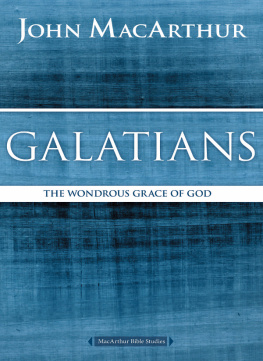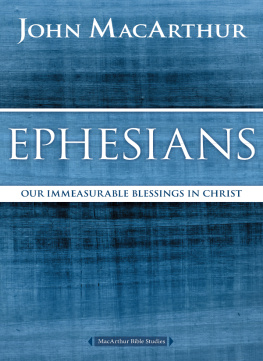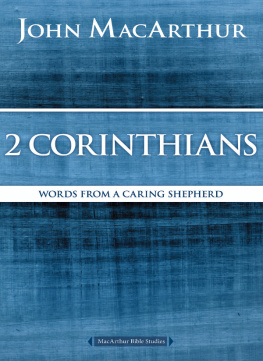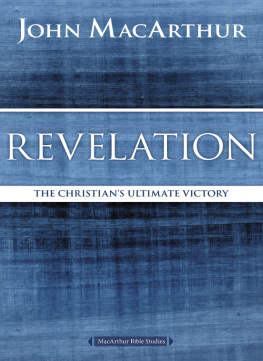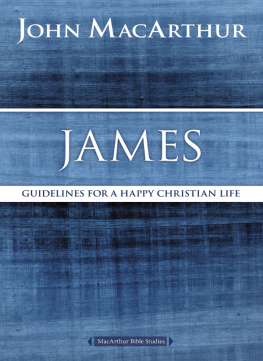
1, 2, & 3 JOHN AND JUDE
MACARTHUR BIBLE STUDIES
Copyright 2007 by John MacArthur.
All rights reserved. No portion of this book may be reproduced, stored in a retrieval system, or transmitted in any form or by any meanselectronic, mechanical, photocopy, recording, or any otherexcept for brief quotations in printed reviews, without the prior permission of the publisher.
Published in Nashville, Tennessee, by Nelson Books, an imprint of Thomas Nelson. Nelson Books and Thomas Nelson are registered trademarks of HarperCollins Christian Publishing, Inc.
Nelson Books titles may be purchased in bulk for education, business, fundraising, or sales promotional use. For information, please email SpecialMarkets@ThomasNelson.com.
Produced with the assistance of the Livingstone Corporation. Project staff include Jake Barton, Mary Horner Collins, and Andy Culbertson. Project editor: Len Woods
Scripture quotations marked NKJV are taken from The Holy Bible, New King James Version. Copyright 1979, 1980, 1982, 1992 Thomas Nelson, Inc. Publishers.
Unleashing Gods Truth, One Verse at a Time is a trademark of Grace to You. All rights reserved.
Keys to the Text and Truth for Today material taken from the following sources:
1 Corinthians. MacArthur New Testament Commentary Series. Copyright 1984, 1996 by John MacArthur. Published by Moody Press, Chicago, Illinois. Used by permission.
Ephesians. MacArthur New Testament Commentary Series. Copyright 1986, 1996 by John MacArthur. Published by Moody Press, Chicago, Illinois. Used by permission.
The Freedom and Power of Forgiveness (electronic ed.) Copyright 1998 by John MacArthur. Published by Crossway Books: Wheaton, Illinois. Used by permission.
The Gospel According to the Apostles. Copyright 2000 by John MacArthur. Published by Word Publishing, a Division of Thomas Nelson, Inc., Nashville, Tennessee.
How to Meet the Enemy. Copyright 1992, 1996 by John MacArthur. Published by Victor Books: Wheaton, Illinois. Used by permission.
James. MacArthur New Testament Commentary Series. Copyright 1998 by John MacArthur. Published by Moody Press, Chicago, Illinois. Used by permission.
The MacArthur Quick Reference Guide to the Bible. Copyright 2001 by John MacArthur. Published by W Publishing Group, a Division of Thomas Nelson, Inc., Nashville, Tennesee.
The MacArthur Study Bible (electronic ed.), John MacArthur, General Editor. Copyright 1997 by Word Publishing. All rights reserved. Used by permission.
Matthew. 17, 815, 1623, 2428. MacArthur New Testament Commentary Series. Copyright 1989 by John MacArthur. Published by Moody Press, Chicago, Illinois. Used by permission.
1 Timothy. MacArthur New Testament Commentary Series. Copyright 1995 by John MacArthur. Published by Moody Press, Chicago, Illinois. Used by permission.
2 Timothy. MacArthur New Testament Commentary Series. Copyright 1995 by John MacArthur. Published by Moody Press, Chicago, Illinois. Used by permission.
Truth for Today. Copyright 2001 by John MacArthur. Published by J. Countryman: Nashville, Tennessee. Used by permission.
Cover Art by Holly Sharp Design
Interior Design and Composition by Joel Bartlett, Livingstone Corporation
ISBN-13: 978-0-7180-3518-1
ISBN-13: 978-0-7180-3537-2 (eBook)
First Printing April 2016
In this ebook edition, please use your devices note-taking function to record your thoughts wherever you see the bracketed instructions [Your Notes] or [Your Response Here]. Use your devices highlighting function to record your response whenever you are asked to checkmark, circle, underline, or otherwise indicate your answer(s).
CONTENTS
The epistles title has always been 1 John. It is the first and largest in a series of three epistles that bear the apostle Johns name. Since the letter identifies no specific church, location, or individual to whom it was sent, its classification is as a general epistle. Although 1 John does not exhibit some of the general characteristics of an epistle common to that time (e.g., no introduction, greeting, or concluding salutation), its intimate tone and content indicate that the term epistle still applies to it.
AUTHOR AND DATE
The epistle does not identify the author, but the strong, consistent and earliest testimony of the church ascribes it to John, the disciple and apostle (see Luke 6:1314). This anonymity strongly affirms the early churchs identification of the epistle with John the apostle, for only someone of Johns well-known and preeminent status as an apostle would be able to write with such unmistakable authority, expecting complete obedience from his readers, without clearly identifying himself (e.g., 4:6). He was well-known to the readers, so he didnt need to mention his name.
John and James, his older brother (Acts 12:2), were known as the sons of Zebedee (Matt. 10:24), to whom Jesus gave the name Sons of Thunder (Mark 3:17). John was one of the three most intimate associates of Jesus (along with Peter and Jamessee Matt. 17:1; 26:37), being an eyewitness to and participant in Jesus earthly ministry (1:14). In addition to the three epistles, John also authored the fourth Gospel, in which he identified himself as the disciple whom Jesus loved and as the one who reclined on Jesus breast at the Last Supper (John 13:23; 19:26; 20:2; 21:7, 20). He also wrote the book of Revelation (Rev. 1:1).
Precise dating is difficult because no clear historical indications of date exist in 1 John. Most likely John composed this work in the latter part of the first century. Church tradition consistently identifies John in his advanced age as living and actively writing during this time at Ephesus in Asia Minor. The tone of the epistle supports this evidence since the writer gives the strong impression that he is much older than his readers (e.g., my little children2:1, 18, 28). The epistle and Johns gospel reflect similar vocabulary and manner of expression. Such similarity causes many to date the writing of Johns epistles as occurring soon after he composed his gospel. Since many date the gospel of John during the later part of the first century, they also prefer a similar date for the epistles. Furthermore, the heresy John combats most likely reflects the beginnings of Gnosticism, which was in its early stages during the latter third of the first century, when John was actively writing. Since no mention is made of the persecution under Domitian, which began about AD 95, it may have been written before that began. In light of such factors, a reasonable date for 1 John is ca. AD 9095. It was likely written from Ephesus to the churches of Asia Minor over which John exercised apostolic leadership.
BACKGROUND AND SETTING
Although he was greatly advanced in age when he penned this epistle, John was still actively ministering to churches. He was the sole remaining apostolic survivor who had intimate, eyewitness association with Jesus throughout His earthly ministry, death, resurrection, and ascension. The church Fathers (e.g., Justin Martyr, Irenaeus, Clement of Alexandria, Eusebius) indicate that after that time, John lived at Ephesus in Asia Minor, carrying out an extensive evangelistic program, overseeing many of the churches that had arisen, and conducting an extensive writing ministry (e.g., epistles, the gospel of John, and Revelation). One church Father (Papias), who had direct contact with John, described him as a living and abiding voice. As the last remaining apostle, Johns testimony was highly authoritative among the churches. Many eagerly sought to hear the one who had firsthand experience with the Lord Jesus.
Next page
